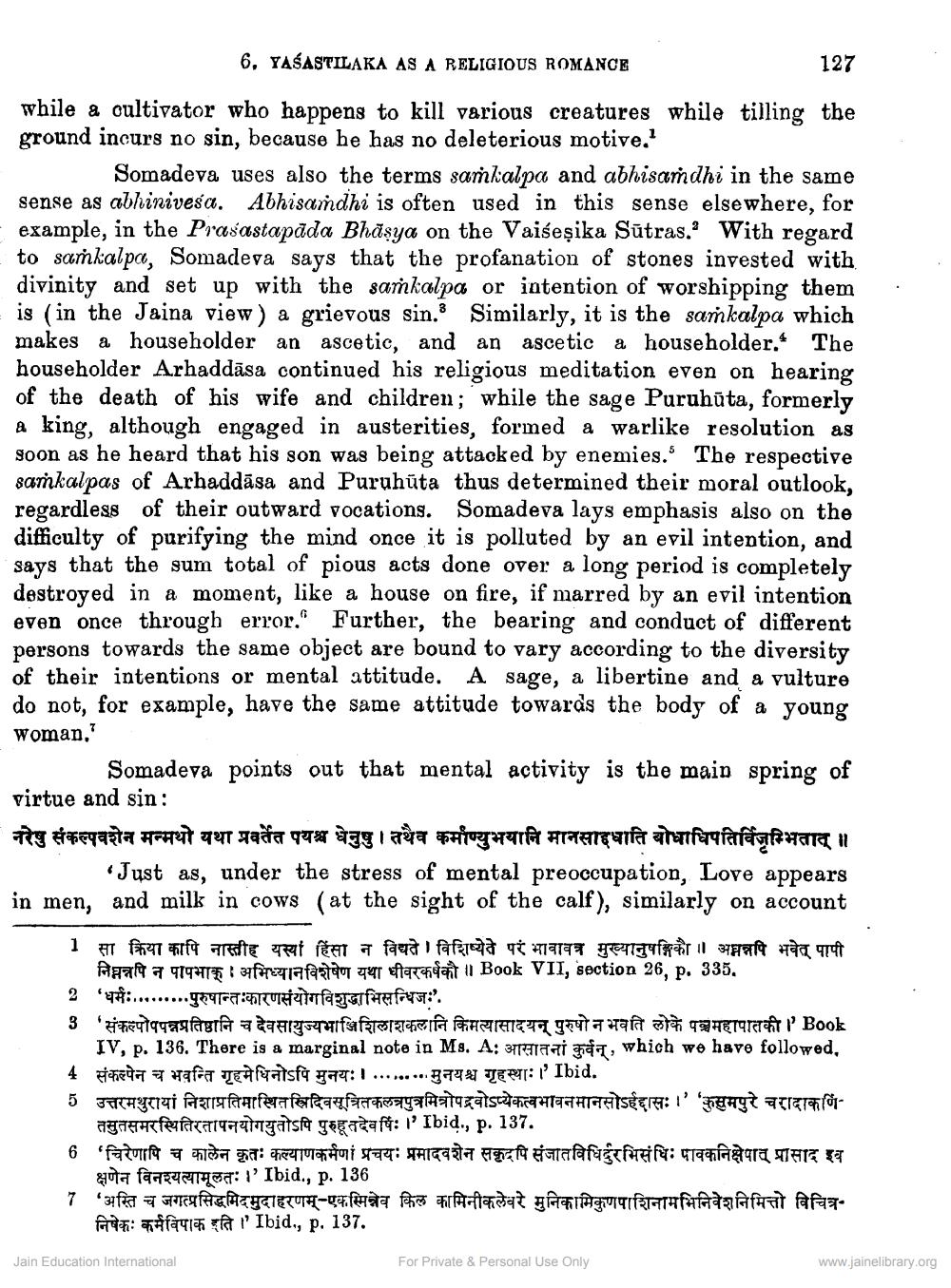________________
6. YASASTILAKA AS A RELIGIOUS ROMANCE
127
while a cultivator who happens to kill various creatures while tilling the ground incurs no sin, because he has no deleterious motive.?
Somadeva uses also the terms saņkalpa and abhisardhi in the same sense as abhinivesa. Abhisamdhi is often used in this sense elsewhere, for example, in the Prasastapada Bhāsya on the Vaisesika Sūtras. With regard to saṁkalpa, Somadeva says that the profanation of stones invested with divinity and set up with the samkalpa or intention of worshipping them is (in the Jaina view) a grievous sin. Similarly, it is the samkalpa which makes a householder an ascetic, and an ascetic a householder. The householder Arhaddāsa continued his religious meditation even on hearing of the death of his wife and children; while the sage Puruhūta, formerly a king, although engaged in austerities, formed a warlike resolution as soon as he heard that his son was being attacked by enemies. The respective sankalpas of Arhaddāsa and Puruhūta thus determined their moral outlook, regardless of their outward vocations. Somadeva lays emphasis also on the difficulty of purifying the mind once it is polluted by an evil intention, and says that the sum total of pious acts done over a long period is completely destroyed in a moment, like a house on fire, if marred by an evil intention even once through error. Further, the bearing and conduct of different persons towards the same object are bound to vary according to the diversity of their intentions or mental attitude. A sage, a libertine and a vulture do not, for example, have the same attitude towards the body of a young woman,'
Somadeva points out that mental activity is the main spring of virtue and sin: नरेषु संकल्पवशेन मन्मथो यथा प्रवर्तेत पयश्च धेनुषु । तथैव कर्माण्युभयानि मानसाहधाति बोधाधिपतिर्विजृम्भितात् ॥
Just as, under the stress of mental preoccupation, Love appears in men, and milk in cows (at the sight of the calf), similarly on account
1 सा क्रिया कापि नास्तीह यस्यां हिंसा न विद्यते । विशिष्येते परं भावावत्र मुख्यानुषङ्गिकौ ॥ अनन्नपि भवेत् पापी
AT HIT I femafaatan er efter pont a Book VII, section 26, p. 335. 2 .........gera PTURAM stafius:'. 3 'संकल्पोपपन्नप्रतिष्ठानि च देवसायुज्यमाजिशिलाशकलानि किमत्यासादयन् पुरुषो न भवति लोके पञ्चमहापातकी।' Book
IV, p. 136. There is a marginal note in Ms. A: Talatai at, which we have followed, 4 at 7 wafa Teofratsa gay: 1 .........gage IEET: 1' Ibid. 5 उत्तरमथुरायां निशाप्रतिमास्थित त्रिदिवसूत्रितकलत्रपुत्रमित्रोपद्रवोऽप्येकत्वभावनमानसोऽहंदासः।' 'कुसुमपुरे चरादाकर्णि
agtfe fataligātsfa gagacaft: 'Ibid., p. 137. 6 'चिरेणापि च कालेन कृतः कल्याणकर्मणां प्रचयः प्रमादवशेन सकृदपि संजातविधिर्दुरभिसंधिः पावकनिक्षेपात् प्रासाद इव
puta fattaa: 1' Ibid., p. 136 7 'अस्ति च जगत्प्रसिद्धमिदमुदाहरणम्-एकस्मिन्नेव किल कामिनीकलेवरे मुनिकामिकुणपाशिनामभिनिवेशनिमित्तो विचित्र
97: Fafanim a l' Ibid., p. 137.
Jain Education International
For Private & Personal Use Only
www.jainelibrary.org




